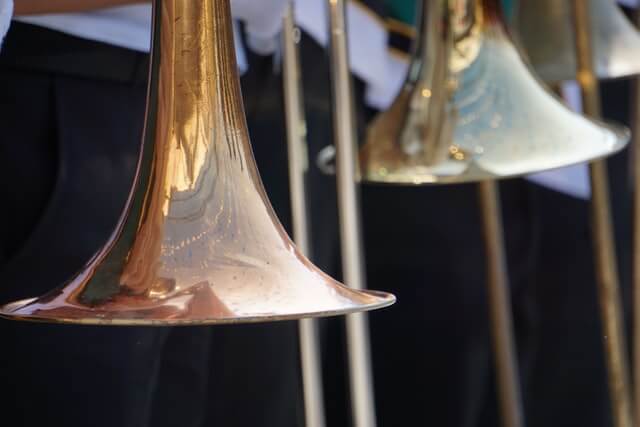Why does expensive trombone cost so much?
- Level of the trombone
- Quality Control
- Quality of material
- Brand
- Where the trombones are Manufactured
- Lacquer finish
- Accessories
The general level of the instrument, the finish used on it, the material the bell is constructed of, and any accessories included are the key elements that impact the cost of a trombone.
The cost of a trombone built by a high-quality manufacturer is typically higher than that of a low-quality one. Prospective trombone buyers have the option of selecting between student, intermediate, or professional trombones, depending on the quality of the instrument. Lacquer finishes are less expensive than silver or gold plated ones. The bells can be made of either sterling silver or nickel, further add to the instrument’s cost.
Here are 7 reasons why expensive trombone cost so much:
-
Level of the trombone
The level of the trombone is the simplest aspect that affects the price. The price of a student trombone reflects the fact that it is not made to the same standard as a professional trombone. A student trombone is the most affordable trombone option. Trombones for professional or advanced players typically cost the most. Instruments that fall in the middle of the spectrum in terms of price are called intermediate level instruments.
-
Quality Control
One of the main reasons why costly trombones are so expensive is that they have undergone a rigorous quality control process. To ensure that the trombone is properly setup and that the materials are of high quality, they must all be thoroughly inspected. Checks tend to be better on more expensive trombones.
So what is being inspected?
The way the trombone is set up is an important part of the inspection process. After the trombones is set up, modifications can be made if necessary, but costly trombones require little to no adjustment.
Setup guarantees that the trombones does not have issues like poor intonation, which can make it sound out of tune.
The slide, the bell and the mouthpiece themselves are just a few of the components that go into a setup. All of these elements will affect playing.
If the trombone’s exterior has any flaws or imperfections, these will also be inspected.
-
Quality of material
There are several factors that contribute to the price of a more expensive trombone, including the use of better material.
The material used to construct the trombone’s bell can also influence the instrument’s price. Most student trombone bells are constructed of yellow brass, which is inexpensive and commonly found in these instruments. Rose brass, which is slightly more expensive, is typically used in intermediate instruments because it produces a more mellow tone.
The most expensive bell materials used on trombones are sterling silver and nickel, which are utilized on professional level instruments. The richness of the sound produced by these high-end materials far exceeds that of lower-cost alternatives.
-
Brand
The brand is the next item on the to-do list. Yamaha and Bach are the two most popular trombones manufacturers in the world. Many well-known trombonists have used these trombones over the years because they’ve been around for so long and have such a solid history.
Also, they produce trombones of the highest quality and have a brand name that attracts a premium price. When it comes to trombones made by newer and less well-known makers, the price tags tend to be lower.
-
Where the trombones are Manufactured
The location of the trombones manufacturing might also have a significant impact on its pricing. There is a big debate as to whether the region a trombone is manufactured in, dictates the quality of the instrument. Some countries make better trombones than others, yet this is a widely held belief.
Material quality, improved craftsmanship, and quality control methods all play a role in this.
In general, trombones made in China, Mexico, and Indonesia are less expensive, while high-end trombones makers like bach and yamaha look to U.S and Japan for their mid-to-high-end trombones because of their reputations for creating high-quality instruments.
-
Lacquer finish
There is a direct correlation between the price of a trombone and its finish. Lacquer is the most common finish, and it is also the least expensive. Certain trombones are more expensive because of their appearance.
If you want a trombone that stands out from the crowd and has a high level of craftsmanship, you should expect to pay a little extra.
Silver plated coatings do not damper the instrument’s sound as much as lacquer does, but they are more expensive. Maintenance is the biggest problem with silver plated finishes. Gold finishes are similar to silver in tone, but they are also more durable, making them even more pricey.
-
Accessories
The cost of a trombone is affected by any additional accessories that are supplied with the instrument. For example, a trombone counterweight keeps the instrument’s bell from being too heavy which can lead to an increase the price. The quality of some instruments can be maintained by using lubricants that are included with the instrument. The price of an instrument rises in direct proportion to the number of extras it comes with.
Why Does Expensive Trombone Cost so Much?
Do You Need an Expensive trombone?
If you’re going to buy a trombone, does it matter how much money you spend on it? The answer is no! If you want a fantastic trombone sound, you don’t need to spend a lot of money. Generally, the difference between a $500 trombone and a $2000 isn’t 4 times as good. It’s all up to you, really.







